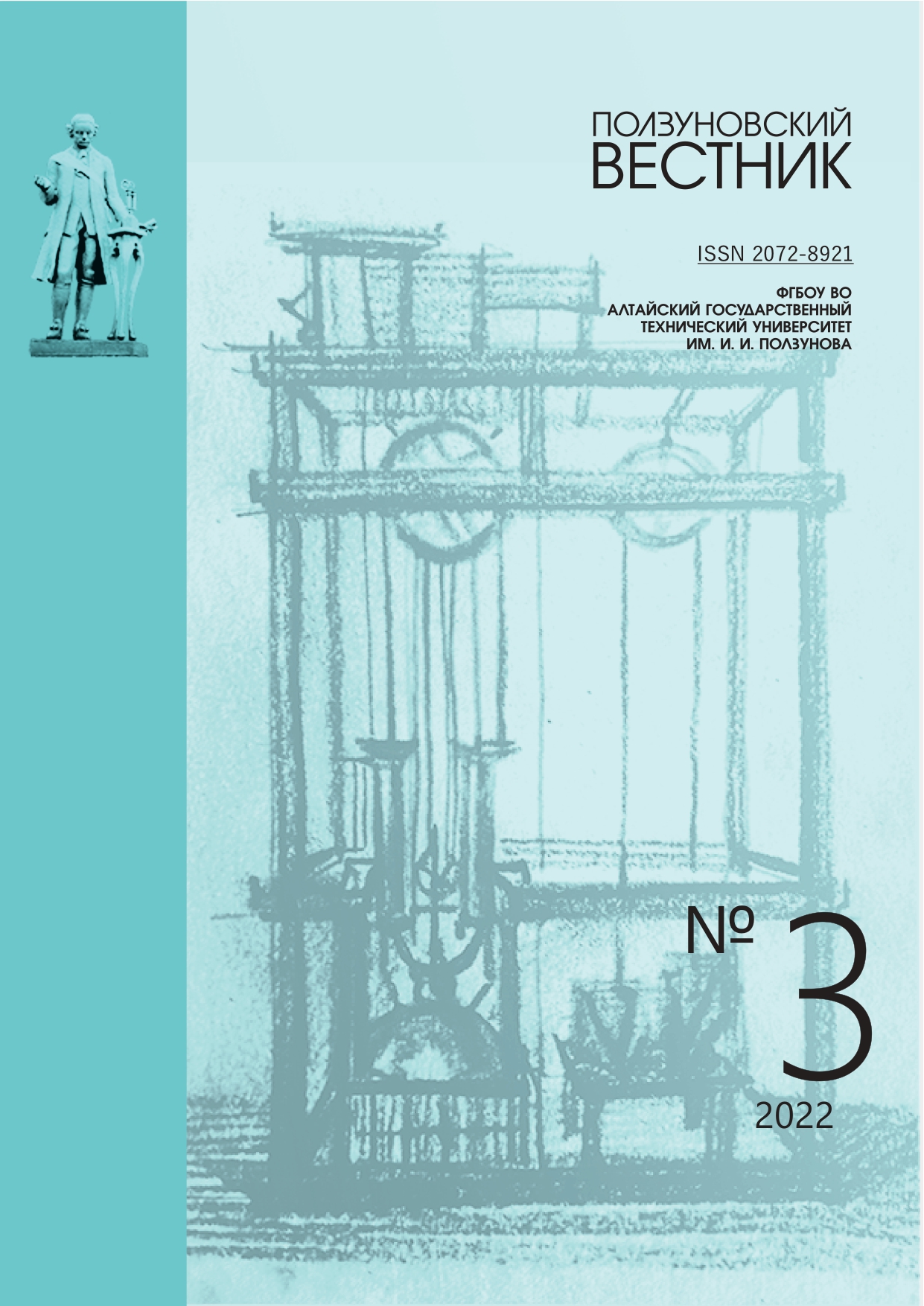JUSTIFICATION OF THE TECHNOLOGICAL MODE OF BLANCH-ING SEMI-FINISHED PRODUCTS FROM JERUSALEM ARTICHOKE TUBERS FOR PREPARATION OF ECO-SNACKS
EDN: RCUVVH
DOI:
https://doi.org/10.25712/ASTU.2072-8921.2022.03.020Keywords:
jerusalem artichoke, eco-snacks, blanching, citric acid solution, whey, peroxidase, technological regimeAbstract
One of the problems that needs to be solved during the processing of Jerusalem artichoke is the change in sensory characteristics, including the darkening of semi-finished products and the formation of coffee flavor during heat treatment. These undesirable changes are associated with the oxidation of polyphenols and the formation of compounds with a dark color. Blanching is used to inactivate enzymes, change the structure of raw materials, and reduce microbiological contamination. The authors investigated the effect of blanching duration and temperature in liquid media on the physico-chemical parameters of jerusalem artichoke semi-finished products, as well as on the inactivation of the peroxidase enzyme. Blanching was carried out: in water (solution No. 0), in a solution of 2 % citric acid (solution No. 1) and in whey (solution No. 2) at a temperature of 65 ° C, 80 ° C and 95 ° C for 3 to 9 minutes. The activity of peroxidase was evaluated by colorimetric method, the hardness of semi-finished products - on the device "Structurometer-ST1". The model specification was carried out in the Statistica program using bicubic spline interpolation. Regression equations of the dependence of the content of peroxidase and hardness of jerusalem artichoke semi-finished products on the temperature and duration of blanching in various media are obtained. The conducted studies substantiate the expediency of blanching semi-finished jerusalem artichoke products in whey to obtain eco-snacks. The optimal mode of blanching in milk whey has been established: temperature 80 ° C, duration from 6 to 9 minutes. At the same time, the activity of peroxidase decreases by 87.0 % from the initial value, the neutral taste and smell, the color of the product are preserved − from milky white to cream
References
Oniszczuk, T., Kasprzak-Drozd, K., Olech, M., Wójtowicz, A. Nowak, R. Rusinek, R. Oniszczuk, A. (2021). The Impact of Formulation on the Content of Phenolic Compounds in Snacks Enriched with Dracocephalum moldavica L. Seeds: Introduction to Receiving a New Functional Food Product, 26 (5), https://doi.org/10.3390/molecules26051245.
Dudarev, I., Panasyuk, S., Taraymovich, I. Say, V. (2021). Effect of fruit and vegetable blanching and compression on the loss of multilayer chips. INMATEH - Agricultural Engineering, (64), 247-256, https://doi.org/10.35633/inmateh-64-24.
Shamkova, N.T., Vereshchagina, A.I., Dobrovolskaya, A.V. Todorova, A.Z. (2020). News of higher educational institutions. Food technology, 5-6 (377-378), 46-49 (In Russ.). https://doi.org/10.26297/ 0579-3009.2020.5-6.10.
F. Michel, L.M. Sanchez-Siles M. Siegrist. (2021). Predicting how consumers perceive the naturalness of snacks: The usefulness of a simple index. Food Quality and Preference, (94), https://doi.org/10.1016/j.foodqual.2021.104295.
Román, S., Sánchez-Siles, L.M. Siegrist, M. (2017). The importance of food naturalness for consumers: Results of a systematic review. Trends in Food Science and Technology, (67), 44-57, https://doi.org/10.1016/j.tifs.2017.06.010.
Sudhakar, A., Dash, S.K., Bal, L.M., Sahoo, N.R. Rayaguru, K. (2021) Journal of the Indian Chemical Society, 98(10) https://doi.org/10.1016/ j.jics.2021.100160.
Kowalska, H., Marzec, A., Kowalska, J., Samborska, K., Tywonek, M. Lenart, A. (2018). Development of apple chips technology. Heat and Mass Transfer/Waerme-Und Stoffuebertragung, 54(12), 3573-3586 https://doi.org/10.1007/s00231-018-2346-y.
Shariati, M.A., Khan, M.U., Hleba, L., Souza, C.K., Tokhtarov, Z., Terentev, S. Kantimerova, M. (2021). The use of dry Jerusalem artichoke as a functional nutrient in developing extruded food with low glycaemic index. Journal of Microbiology, Biotechnology and Food Sciences, 10(6), 1-8. https://doi.org/10.15414/jmbfs.4737.
Castellanos-Gallo, L., Galicia-García, T., Estrada-Moreno, I.A., Mendoza-Duarte, M., Márquez-Meléndez, R., Portillo-Arroyo, B., Soto-Figueroa, C., Leal-Ramos, M.Y. Aldana, D.S. (2019). Development of an Expanded Snack of Rice Starch Enriched with Amaranth by Extrusion Process. Molecules, 24, 2430, https://doi.org/10.3390/molecules24132430.
Radovanovic, A., Stojceska, V., Plunkett, A., Jankovic, Milovanovic, S. Cupara, D.S. (2015). The use of dry Jerusalem artichoke as a functional nutrient in developing extruded food with low glycaemic index. Food Chemistry, 177, 81-88. https://doi.org/10.1016/j.foodchem.2014.12.096.
Yang, L., Sophia, H.Q., Corscadden, K. Chibuike, S.U. (2015). The prospects of Jerusalem artichoke in functional food ingredients and bioenergy production. Biotechnology Reports, 5, 77-88. https://doi.org/10.1016/j.btre.2014.12.004.
Barkhatova, T.V., Nazarenko, M.N., Kozhukhova, M.A. Khripko, I.A. (2015). Obtaining and identification of inulin from jerusalem artichoke (helianthus tuberosus) tubers. Foods and Raw Materials, 3 (2), 13-22. https://doi.org/10.12737/13115.
Guerrero, B.G., Montero-Montero, J.C., Fernández-Quintero, A., Rivera-Agredo, Y.J. Patiño, B.O. (2019). The importance of food naturalness for consumers: Results of a systematic review. Gallego. S. DYNA, 86, 298–303 https://doi.org/10.15446/ dyna.v86n209.73071.
Khuenpet, K., Jittanit, W., Sirisansaneeyakul, S. Srichamnong, W. (2015). Effect of Pretreatments on Quality of Jerusalem Artichoke (Helianthus tuberosus L.) Tuber Powder and Inulin Extraction. Transactions of the ASABE, 58(6), 1873-1884. https://doi.org/10.13031/trans.58.11036.
Bach, V., Jensen, S., Clausen, M.R., Bertram, H.C. Edelenbos, M. (2013). Enzymatic browning and after-cooking darkening of Jerusalem artichoke tubers ( Helianthus tuberosus L.). Food Chemistry, 141(2), 1445-1450. https://doi.org/10.1016/j.foodchem.2013. 04.028.
Domasev, M.V. Gnatyuk, S.P. (2009). Color, color management, color calculations and measurements. St. Petersburg: Peter. (In Russ.).
Downloads
Published
How to Cite
Issue
Section
License
Copyright (c) 2022 Natalia T. Shamkova, Olga V. Rudenko, Maya Yu. Tamova, Albina A. Varivoda, Tatiana V. Yakovleva

This work is licensed under a Creative Commons Attribution 4.0 International License.















 .
. This work is licensed under a
This work is licensed under a 
